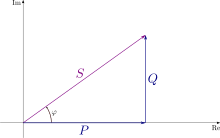Volt-ampere
This article may be too technical for most readers to understand. (December 2019) |
| volt-ampere | |
|---|---|
 Apparent power () is the magnitude of the vector sum of real power vector () and reactive power vector (); is the phase between voltage and current. | |
| General information | |
| Unit system | SI units |
| Unit of | Apparent power |
| Symbol | V⋅A |
| Conversions | |
| 1 V⋅A in ... | ... is equal to ... |
| SI base units | 1 kg⋅m2⋅s−3 |
A volt-ampere (SI symbol: V⋅A or V A; also VA) is the unit used for the apparent power in an electrical circuit. The apparent power equals the product of root mean square voltage and root mean square current.[1] In direct current (DC) circuits, this product is equal to the real power[2] in watts. Volt-amperes are usually used for analyzing alternating current (AC) circuits. The volt-ampere is dimensionally equivalent to the watt (in SI units, 1 V⋅A = 1 W). VA rating is most useful in rating wires and switches (and other power handling equipment) for inductive loads.
Unit[]
For a simple electrical circuit running on direct current, the electrical current and voltage are constant. In that case, the real power (P, measured in watts) is the product of the electrical current (I, measured in amperes) and the voltage from one side of the circuit to the other (V, measured in volts):
However, for alternating current, both the voltage and current are oscillating. Instantaneous power is still the product of instantaneous current and instantaneous voltage, but if both of those are ideal sine waves driving a purely resistive load (like an incandescent light bulb), average power becomes (with subscripts designating peak amplitude and root mean square (RMS)):
More generally, when voltage and current are no longer in phase, these products no longer compute average power but a new apparent power (S, measured in volt-amperes):
The relationship between real power (the average power above) and apparent power is described by the power factor. With a purely resistive load, they are the same: the apparent power is equal to the real power. Where a reactive (capacitive or inductive) component is present in the load, the apparent power is greater than the real power as voltage and current are no longer in phase. In the limiting case of a purely reactive load, current is drawn but no power is dissipated in the load.
Some devices, including uninterruptible power supplies (UPSs), have ratings both for maximum volt-amperes and maximum watts. The VA rating is limited by the maximum permissible current, and the watt rating by the power-handling capacity of the device. When a UPS powers equipment which presents a reactive load with a low power factor, neither limit may safely be exceeded.[3] For example, a (large) UPS system rated to deliver 400,000 volt-amperes at 220 volts can deliver a current of 1818 amperes (these are RMS values).
VA ratings are also often used for transformers; maximum output current is then VA rating divided by nominal output voltage.[4] Transformers with the same sized core usually have the same VA rating.
The convention of using the volt-ampere to distinguish apparent power from real power is allowed by the SI standard.[5]
Volt-ampere reactive []
In electric power transmission and distribution, volt-ampere reactive (var) is a unit of measurement of reactive power. Reactive power exists in an AC circuit when the current and voltage are not in phase. The term var was proposed by the Romanian electrical engineer Constantin Budeanu and introduced in 1930 by the IEC in Stockholm, which has adopted it as the unit for reactive power.
Special instruments called varmeters are available to measure the reactive power in a circuit.[6]
The unit "var" is allowed by the International System of Units (SI) even though the unit var is representative of a form of power.[7] SI allows one to specify units to indicate common sense physical considerations. Per EU directive 80/181/EEC (the "metric directive"), the correct symbol is lower-case "var",[8] although the spellings "Var" and "VAr" are commonly seen, and "VAR" is widely used throughout the power industry.
References[]
- ^ Ciletti, M. D., Irwin, J. D., Kraus, A. D., Balabanian, N., Bickard, T. A., and Chan, S. P. (1993). Linear circuit analysis. In Electrical Engineering Handbook, edited by R. C. Dorf. Boca Raton: CRC Press. (pp.82–87)
- ^ IEEE 100 : the authoritative dictionary of IEEE standards terms.-7th ed. ISBN 0-7381-2601-2, page 14
- ^ Watt Ratings Differs from Volt Amp Ratings APC
- ^ "Transformers and VA Ratings". 2012-06-27. Retrieved 13 December 2016.
- ^ "SI Brochure" (8th ed.).
- ^ Wildi, Theodore (2002). Electrical Machines, Drives and Power Systems. Pearson. p. 137. ISBN 978-0-13-093083-5.
- ^ SI Brochure, 8th ed.
- ^ Council Directive on units of measurements 80/181/EEC Chapter 1.2.3., p. 6: "Special names for the unit of power: the name volt–ampere (symbol ‘VA’) when it is used to express the apparent power of alternating electric current, and var (symbol ‘var’) when it is used to express reactive electric power."
 This article incorporates public domain material from the General Services Administration document: "Federal Standard 1037C".
This article incorporates public domain material from the General Services Administration document: "Federal Standard 1037C".
- Electricity
- Units of power






